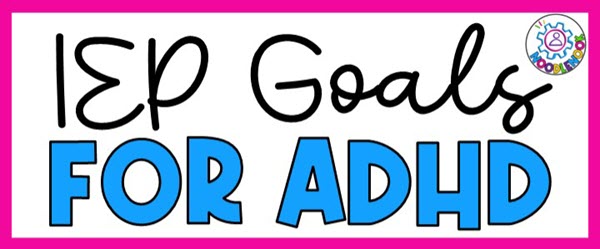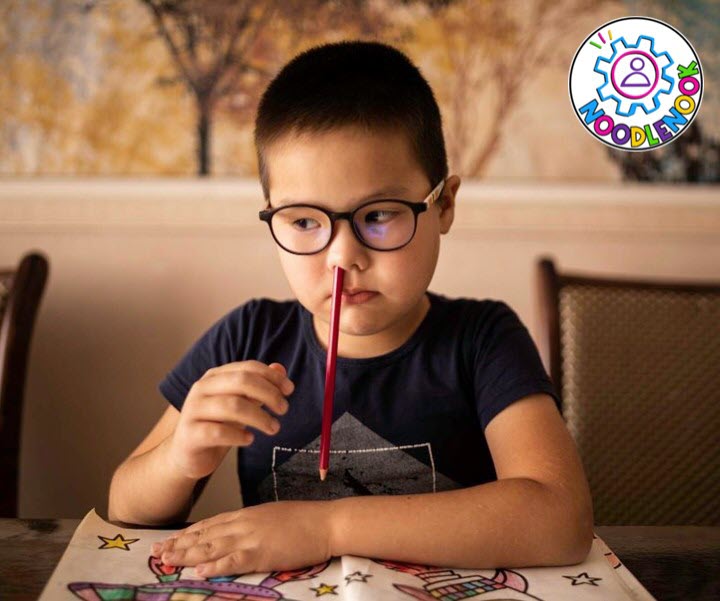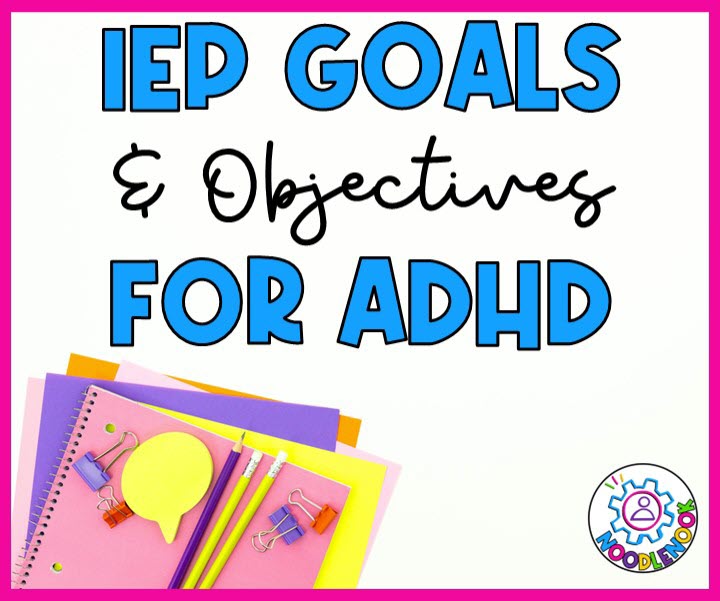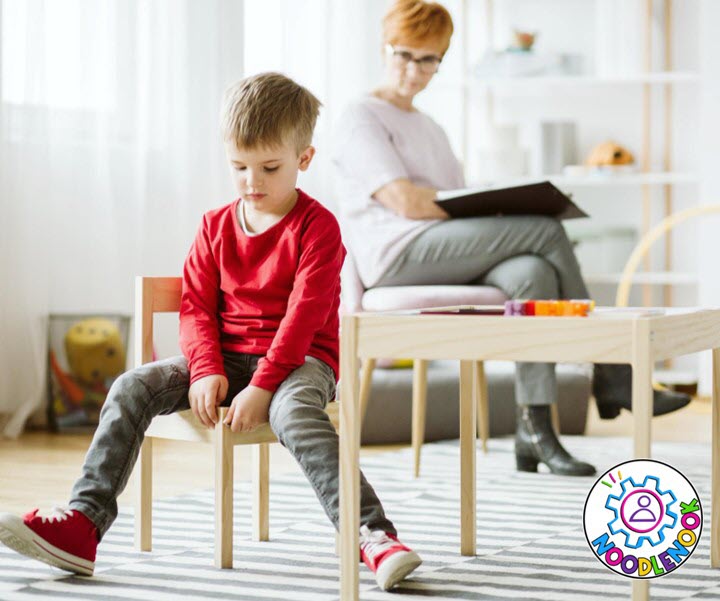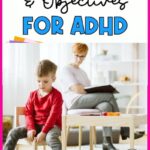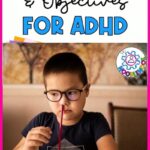It’s critical when working with an IEP team that general and special education teachers draft meaningful and measurable goals for students with attention deficit hyperactivity disorder (ADHD). Drafting SMART goals that focus on areas of deficit, like organization skills, social skills, time management, self-regulation skills, and executive functioning are the most critical. They support a student in success in their related academic goals, but also set a student up to be a more successful adult (and that’s the ultimate goal, right)? If you are prepping for your next IEP meeting and looking for some effective IEP goals and objectives for ADHD that support the academic success and unique needs of a students, then this post is a must-read!
Hallmarks of ADHD
Students with ADHD typically fall into three camps. There are students who struggle specifically with attention deficits, characterized by difficulties sustaining focus, easily getting distracted, and frequently making careless mistakes. These students may have trouble organizing tasks and tend to avoid activities that require prolonged mental effort.
Others will struggle with hyperactivity, displaying excessive motor activity, such as fidgeting, restlessness, and difficulty remaining seated. They may have a constant need to be “on the go” or engage in excessive talking. These students may experience challenges with impulse control and find it hard to wait their turn or follow rules consistently.
Finally, some students show symptoms of both attention deficits and hyperactivity. They exhibit a combination of inattentive and hyperactive-impulsive behaviors. These students may struggle with maintaining focus, controlling impulses, and managing their activity levels appropriately.
For students with a combination of attention deficits and hyperactivity, their challenges stem from both difficulty sustaining attention and managing excessive motor activity. It is important to provide individualized support and accommodations to address their specific needs and help them be successful academically and socially.
Supporting Students with ADHD in the Classroom
To effectively support students with ADHD in the classroom, teachers can employ a variety of strategies. After all, we play a crucial role in recognizing and addressing the individual needs of each student with ADHD.
Data-Driven Decision
To start, using teacher observation can identify the greatest areas of need. From there, we can identify specific goals for the student’s academic and behavioral progress. By regularly assessing the student’s progress, both academic and behavioral, teachers can make data-informed decisions and adjust their instructional approach accordingly.
Additionally, we must analyze and review data to make changes when needed. Regular data collection on the student’s behaviors and academic achievement is essential for monitoring progress and making necessary adjustments to interventions. It’s how we know if things are working and what to do next. From there, we can use this data to inform the development of effective goals and measurable IEP goals at the next annual review.
Direct Instruction
When instruction is tailored to the student’s ability and learning style, it helps students navigate the general education curriculum. This includes breaking down complex tasks into smaller, more manageable steps and providing explicit instruction. Teachers can incorporate measurable annual goals into the student’s IEP to ensure that the child’s educational needs are addressed effectively.
Specific Strategies
To support executive functioning and emotional control, teachers can teach self-regulation strategies such as positive self-talk, self-monitoring checklists, and the use of graphic organizers. They can also encourage appropriate emotional responses by providing guidance and modeling appropriate behaviors.
Assistive Technology
Incorporating assistive technology and related service professionals, such as school psychologists, can further enhance the student’s organizational skills and academic performance. Technology tools and apps can assist with executive functioning skills and help students stay on track with due dates and task management.
Movement Breaks
Movement breaks and the use of electronic devices, when appropriate, can provide valuable outlets for physical activity and help students maintain focus. Teachers can also create small group settings to facilitate peer interactions and functional play actions, fostering social-emotional learning and problem-solving skills.
High School Considerations
In high school, where the demands of academics and independence are greater, teachers can collaborate with the student to set short-term objectives and develop self-regulation strategies that will help them in adulting.
Overall, it is important for teachers to implement best practices that consider the unique learning disabilities and neurodevelopmental disorder characteristics associated with ADHD. By employing a combination of effective IEP goals, evidence-based strategies, and collaboration with related service professionals, teachers can provide the necessary support for students with ADHD to succeed academically, socially, and emotionally.
Struggling with Attention and Focus
Students with ADHD often struggle with attention and focus due to the neurodevelopmental nature of the disorder. In fact ADHD is often characterized by difficulties in regulating attention, and impulsivity, and hyperactivity. Here’s what that looks like in students:
Inattention: Students with ADHD may struggle with sustaining attention for extended. Time. We’ll see they become easily distracted by irrelevant stimuli. Sometimes they have difficulty focusing on tasks, especially when they’re not inherently stimulating or interesting to them.
Hyperactivity: Hyperactive tendencies can make it challenging for students with ADHD to sit still and remain focused. They feel a strong need to move or engage in fidget behaviors. That desire to be moving around can disrupt attention and concentration.
Impulsivity: Impulsivity can lead a student with ADHD to act without thinking or interrupt ongoing tasks and conversations. This impulsivity can interfere with their ability to maintain focus and sustain attention.
Classroom Interventions for Attention and Focus
As a teacher in the classroom, it requires dedication in order to adequately support a student with ADHD so that they are successful. If a student in your room specifically struggles with attention and focus, here are some classroom interventions that can help.
Active Engagement: Incorporate active learning strategies that involve movement and hands-on activities. This can help channel students’ excess energy in productive ways, keeping them engaged and focused.
Attention Prompts: Implement strategies to redirect and refocus students when their attention wavers. This can include gentle reminders, visual cues, or non-disruptive signals to bring their attention back to the task at hand.
Breaks and Movement: Allow for regular breaks and opportunities for movement throughout the day. Incorporate short movement or stretching breaks to provide outlets for physical activity and help students re-energize.
ADHD IEP Goals and Objectives: Examples for Attention and Focus
As you write your IEP goals and objectives for ADHD students, follow the formatting that is provided in this post, How to Write an IEP Goal – 4 Essential Elements. With that in mind, here are a few conditions, behaviors and criteria for your IEP goals:
Sustained Attention
Here are some IEP goals and objectives for ADHD focused on sustained attention:
| CONDITION | BEHAVIOR (with SUPPORT OR STRATEGY) | CRITERIA | |
| When provided with a quiet and distraction free environment | The student will remain focused on the given task | Using a visual timer or countdown | For 3 minutes in 8 out of 10 opportunities. |
| When provided with a structured and organized workspace | The student will stay focused on a project or task for 15 continuous minutes | Using a task checklist | In 80% of opportunities. |
| During independent work time | The student will sustain attention for the entire block | Using self-monitoring techniques (highlighting, note taking, audio notes) | In 70% of opportunities. |
| During class discussions or group activities | The student will remain on task for 10 continuous minutes | Using a preferred fidget toy our stress ball to channel energy | In 3 out of 4 opportunities. |
Task Initiation
Here are some IEP goals and objectives for ADHD focused on task initiation:
| CONDITION | BEHAVIOR (with SUPPORT OR STRATEGY) | CRITERIA | |
| When given clear instructions and visual cues | The student will independently start a task within 2 minutes | Using a visual schedule or checklist to outline tasks and steps | In 7 out of 10 opportunities |
| When provided with a daily schedule or routine | The student will independently begin each activity within 1 minute of schedule | Using a visual timer or countdown to indicate when to start each task | In 8 out of 10 opportunities |
| When transitioning from one activity to another | The student will smoothly and promptly begin the next task or activity within 1 minute of the transition cue | By using a transition sequence (put away materials, walk to get needed items, return to workspace, start task) | In 9 out of 10 opportunities |
| When presented with a written assignment or task | The student will independently begin working on the assignment within 2 minutes | Using a writing template to organize thoughts | In 6 out of 10 opportunities |
| During independent work or study periods | The student will start working on the assigned task or studying within 3 minutes of arrival | Using a preferred focus strategy or technique (e.g., color-coding, mind maps) | In 8 out of 10 opportunities |
Transition Focus
Here are some IEP goals and objectives for ADHD focused on transitions:
| CONDITION | BEHAVIOR (With SUPPORT/STRATEGY) | CRITERIA | |
| During transitions between activities or classes | The student will maintain focus and attention while moving from one location to another | Using a visual schedule or checklist to provide visual cues and reminders | In 9 out of 10 opportunities |
| When transitioning from one task to another within an activity | The student will smoothly shift attention and focus to the next task within one minute | Using a transition routine or visual cue to signal the end of one task and the start of the next | As measured by time to refocus in seconds. |
| During classroom interruptions or unexpected changes | The student will regain focus and attention within one minute after an interruption or unexpected change | Using self-regulation techniques, such as deep breathing or mindfulness exercises | In 9 out of 10 opportunities |
| When provided with a verbal or visual prompt for transition focus | The student will redirect attention and refocus on the new activity or environment | Using a transition cue or signal, such as a chime or visual timer, to indicate the need to transition focus | The student will refocus within 10 seconds of the transition prompt in 8 out of 10 opportunities |
| During class or group discussions | The student will actively engage in the discussion and maintain focus on the topic | Utilizing visual supports, such as graphic organizers or discussion prompts, to aid in maintaining focus | The student will actively participate and maintain focus throug |
Hyperactivity and Impulse Control
Students with ADHD often struggle with hyperactivity and impulse control, which can significantly impact their ability to focus, stay on task, and regulate their behavior.
Hyperactivity manifests as excessive restlessness, fidgeting, and difficulty staying seated or quiet. These students may have a constant need for movement and may struggle to control their impulses, leading to impulsive actions or interrupting others. It can be challenging for them to resist immediate gratification or think before acting, resulting in impulsive decisions or behaviors that may disrupt classroom routines. These difficulties can make it hard for students with ADHD to engage in structured activities, follow instructions, and maintain positive relationships with peers.
Teacher Interventions for Hyperactivity and Impulse Control
Clear and Structured Environment: Establish a structured and predictable classroom environment with consistent routines and clear expectations. Provide visual schedules and verbal reminders to help students stay organized and understand what is expected of them.
Movement Breaks: Incorporate regular movement breaks into the daily schedule to allow students to release excess energy. These breaks can include short periods of stretching, walking, or engaging in controlled physical activities. Providing opportunities for movement can help students regulate their activity levels.
Seating Arrangement: Consider flexible seating options that allow students to move and change positions comfortably. Providing options like standing desks, stability balls, or fidget tools can help students channel their energy and improve focus.
Task Chunking: Break down tasks and assignments into smaller, manageable parts. Provide clear instructions and visual aids to help students understand and follow through with each step. This can reduce overwhelm and assist students in maintaining focus and completing tasks successfully.
Visual Reminders and Cues: Use visual cues, such as visual schedules, checklists, or timers, to help students stay on track and manage their time effectively. Visual reminders can serve as prompts for self-regulation and help students remember expectations and follow instructions.
Reinforcement and Rewards: Implement a system of positive reinforcement to motivate and reward desired behaviors. Offer praise, tokens, or other incentives for demonstrating self-control, following rules, or completing tasks. This can help motivate students and reinforce positive behavior choices.
Self-Regulation Strategies: Teach students self-regulation techniques, such as deep breathing exercises, mindfulness, or self-calming strategies. Encourage them to recognize their own signs of restlessness or impulsivity and practice these strategies to regain focus and control.
ADHD IEP Goals and Objectives: Examples for Attention and Focus
As you set out to address the needs of a student with hyperactivity on a daily basis, you need an overall goal that supports the child’s needs in terms of being able to better regulate their behaviors and actions. This can be especially difficult in standard academic settings. Some students have a very hard time doing a non-preferred task or doing tasks that require concentration for a given amount of time.
Here are some goals that support a child’s progress in this area:
Self-Regulation
Here are some IEP goals and objectives for ADHD focused on self-regulation:
| CONDITION | BEHAVIOR (With SUPPORT/STRATEGY) | CRITERIA | |
| During challenging tasks | The student will use deep breathing exercises or a self-soothing routine | To remain calm | In 8 out of 10 opportunities |
| When making decisions | The student will use a decision-making framework or checklist | To make a decision within 5 minutes | In 7 out of 10 opportunities |
| When setting goals and monitoring progress | The student will use a goal-setting worksheet or reflection journal | To make sound decisions | In 8 out of 10 opportunities |
| During activities that require focus and minimize distractions | The student will use noise-cancelling headphones or a designated study area | To maintain focus for more than 20 sustained minutes | In 80% of opportunities |
Impulse Control
Here are some IEP goals and objectives for ADHD focused on impulse control:
| CONDITION | BEHAVIOR (With SUPPORT/STRATEGY) | CRITERIA | |
| During challenging tasks | The student will use deep breathing exercises or a self-soothing routine | To remain calm | In 4 out of 5 opportunities |
| When faced with distractions or temptations | The student will resist impulsive actions | Using a self-regulation technique, such as counting to ten or redirecting focus | In 3 out of 5 opportunities |
| During social interactions | The student will exhibit appropriate social responses | Using active listening (looking at the person and nodding) and think before responding (by waiting 3 seconds before answering) | In 2 of 3 opportunities |
| When waiting for a turn or waiting in line | The student will wait patiently without interrupting or acting out | Using a self-regulation strategy, such as counting or deep breathing, to manage impulsivity | In 2 out of 4 opportunities |
| During moments of frustration or anger | The student will manage emotions and avoid impulsive outbursts | Using a self-calming technique, such as taking a break or engaging in a calming activity | In 3 out of 5 opportunities |
Sensory Regulation
Here are some IEP goals and objectives for ADHD focused on sensory regulation:
| CONDITION | BEHAVIOR (With SUPPORT/STRATEGY) | CRITERIA | |
| When experiencing sensory overload or sensitivity | The student will self-regulate and maintain a regulated state | use self-calming techniques, such as deep breathing or taking sensory breaks | In 70% of opportunities |
| During transitions between sensory environments | The student will transition smoothly and adapt to new sensory environments | Using transitional strategies, such as visual schedules or verbal cues, to prepare for changes | In 60% of opportunities |
| When exposed to sensory triggers in the environment | The student will manage sensory triggers and maintain focus or calmness | Using coping strategies, such as wearing noise-cancelling headphones or using a fidget tool | In 3 of 4 opportunities |
| During activities that require sensory modulation | The student will maintain an optimal level of sensory input for engagement and attention | Using sensory tools or strategies to regulate their arousal level, such as using a weighted blanket or taking movement breaks | In 3 out of 4 opportunities |
| When confronted with sensory aversions or sensitivities | The student will request a break | Using the break card system and calming area in the classroom | In 8 out of 10 opportunities |
Emotional Regulation
Here are some IEP goals and objectives for ADHD focused on emotional regulation:
| CONDITION | BEHAVIOR (With SUPPORT/STRATEGY) | CRITERIA | |
| When feeling overwhelmed or anxious | The student will reduce anxiety and regain emotional balance | By accessing the calm down area and practice self-calming techniques, such as deep breathing or visualization exercises | In 3 out of 3 opportunities |
| During moments of disappointment or failure | The student will engage in positive self-talk | By completing a positive self-talk worksheet and then discussing it with a trusted adult | In 100% of occurrences |
| When experiencing strong emotions, such as anger or frustration | The student will manage and express emotions in a healthy and appropriate manner | By using a self-regulation strategy card in the calming area (such as focused breathing or a calming activity) | In 100% of occurrences |
Executive Functioning
Here are some IEP goals and objectives for ADHD focused on executive functioning:
| CONDITION | BEHAVIOR | (With SUPPORT/STRATEGY) | CRITERIA |
| During tasks that require planning and organization | The student will complete tasks with a clear plan and meet deadlines | By completing a visual or written planner to outline steps and deadlines | In 80% of opportunities |
| When facing time management challenges | The student will complete tasks within designated time frames | By setting phone timers or alarms to help stay on track and manage time effectively | In 3 of 4 opportunities |
| During activities that require flexible thinking | The student will demonstrate the ability to generate and consider multiple options | By completing a brainstorming graphic organizer with alternative solutions or perspectives | In 3 out of 4 opportunities |
Social Skills
Here are some IEP goals and objectives for ADHD focused on social skills:
| CONDITION | BEHAVIOR | (With SUPPORT/STRATEGY) | CRITERIA |
| During conversations or group interactions | The student will practice active listening and turn-taking skills | Using the counting method | In 3 out of 5 opportunities |
| When resolving conflicts or disagreements | The student will use a mediation contingency map | To find to positive conflict resolution | In 8 out of 10 opportunities |
| During social situations with unfamiliar peers or settings | The student will reference the “public and private information” sheet | To refrain from oversharing | in 100% of opportunities |
RECAP: ADHD IEP Goals and Objectives Examples
It can be a complex task to draft functional goals that allow a student with ADHD to reach their full potential. Creating short-term steps and developing an appropriate emotional response to common situations will help your students address their behavior goal as well as address academic targets. This post was full of goal examples. I think reading through samples is one of the best ways to draft a more effective individualized education program for students while having the greatest impact on a child’s goals after graduation.
Get More IEP Goal Ideas
If you need more IEP goal banks to reference as you work on your caseload, check out these other posts:
- How to Write an IEP Goal – 4 Essential Elements
- Special Education: IEP at a Glance Printable (Easy Prep)
- List of Student Strengths and Weaknesses for an IEP
- IEP Transition Goal Bank
- Reading Comprehension IEP Goals
- Written Expression IEP Goals: Writing Goals in Special Ed
- Phonemic Awareness IEP Goals
- IEP Goals for Anxiety (What, Why, and How To in Special Ed)
- IEP Goals and Objectives for ADHD Students (with Examples)
- Behavior IEP Goals

